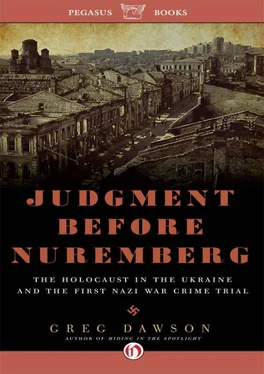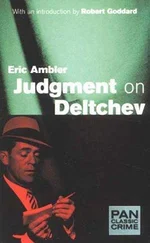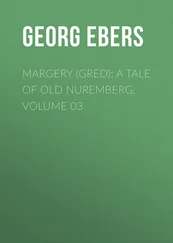Stalin’s reasons for jump-starting the judicial process are not known but could have included: boosting the morale of the battered Soviet people for the battles ahead; putting the rest of the German military on notice about what to expect if it committed similar atrocities; and establishing in the public mind a straight line between the criminal acts of German soldiers in the field and Hitler and the Nazi High Command. And perhaps, in addition, to throw a veil over his own crimes against humanity, including those from the past decade and those he was still planning to commit.
John Balfour, the British minister in Moscow, believed that Stalin was conducting the Kharkov trial in order to throw “a cloak of legality” over random hangings of German prisoners which had been reported in Kiev—where bodies were left twisting in the wind from balconies—and in a village west of Kremenchug after a hasty field court-martial. “The gallows was a tree where a village woman had been executed for killing poultry without permission of the German agricultural authorities” a few months prior, the New York Times reported.
If the Kharkov trial was designed as a cloak of legality, it was exceedingly threadbare by Western standards. There was no presentation of documentary (physical) evidence; defense attorneys (state lawyers) were not permitted to cross-examine witnesses; the judge often acted as a prosecutor in questioning defendants and witnesses; and the guilt of individual defendants was established through confessions, and by linking them to similar crimes committed by other German military in the region—guilt by nonassociation. Two of the defense attorneys had “represented” defendants in the show trials. As Stevens noted, “This, too, was a military tribunal: judges, prosecutor, and attendants were all in uniform.”
In short, the Kharkov trial—along with those held later at the time of the Nuremberg trials—was typical Soviet justice. “While the war crimes trials followed the format of the prewar show trials, they were administered in full accordance with contemporary Soviet laws and definitions of legality,” wrote Prusin. In its own way, Soviet justice was blind. The principles and procedures of the Kharkov courtroom were identical to those used to convict eleven collaborators at Krasnodar just months earlier.
The Soviets held thousands of German prisoners in December 1943. Their reasons for choosing these three—Reinhard Retzlaff, Wilhelm Langheld, and Hans Ritz—to prosecute are as uncertain as Stalin’s motivation for having the trial. Prusin has speculated, “The German defendants were selected to represent an assortment of military ranks and branches of the German armed forces: an NCO (noncommissioned officer) of the Secret Field Police, a captain of military counterintelligence, and an SS second lieutenant. They appeared in court in full military regalia—a rare practice in Soviet trials. The prosecution pointed out that the decorations were rewards received for atrocities committed against Soviet people.” [4] Prusin, “Fascist Criminals to the Gallows!”, Holocaust and Genocide Studies (2003), 6.
With the seats filled and all the actors in place, the Military Tribunal of the 4th Ukrainian Front came to order. Before the packed hall, under bright lights and the hum of motion picture cameras, the Secretary of the Court, Justiciary Captain Kandibin, read the indictment, “In the case of the atrocities committed by the German fascist invaders in the town of Kharkov during the period of their temporary occupation.”
“Under the direction of their superiors, the German fascist troops asphyxiated in specially equipped ‘murder vans,’ hanged, shot or tortured to death many tens of thousands of Soviet people; plundered the property of state, economic, cultural, and public organizations; burned down and destroyed entire towns and thousands of inhabited places; and drove to slavery in Germany hundreds of thousands of the peaceful population. All these crimes and outrages are not isolated facts, but only a link in the long chain of crimes which have been and are being committed by the German invaders on the direct instructions of the German government and the Supreme Command of the German Army.”
The opening salvo was supported by a lengthy rehearsal of Nazi atrocities described by civilian and military witnesses including several Germans. In this nightmare litany, murder by gas wagon seemed the gentlest of methods—a mercy killing compared to the fate of starving prisoners in one camp waiting for food. “During the distribution of scanty rations, soldiers used to set dogs on the exhausted and hungry people,” the indictment stated. “The dogs jumped into the crowd, tore to shreds the clothes and bodies of the war prisoners, knocked them down, dragged and mauled them on the ground. Some of the badly mauled prisoners and civilians were then shot by soldiers and thrown over the fence so as to avoid bothering about their treatment.”
The indictment asserted that the “whole weight of responsibility” for atrocities committed by Nazis in Kharkov “is borne by the leaders of the predatory fascist government of Germany and by the Supreme Command of the German Army”—but that the instruments of their terror were equally guilty. One by one, the indictment detailed the crimes of Retzlaff, Ritz, Langheld, and Mikhail Bulanov, the Russian collaborator.
“As a result of the foregoing exposition,” the indictment concluded, “the persons enumerated are committed for trial before the Court of the Military Tribunal.”
Symbolically at least, this was the trial of the men who murdered my grandparents and great-grandparents at Drobitsky Yar. Yes, it could have been worse. They could have been torn to pieces by dogs. If this was a “show trial,” it was because the victims were showing the perpetrators far more justice than they deserved.
After the painfully deliberate reading of the indictment in German, all the accused pleaded guilty, and questioning of the defendants finally began in the trial which “opens the period of great, awful judgment on Germans who have been transgressing the law of humanity,” wrote journalist Alexei Tolstoy in Pravda.
In dramatic illustration of the Soviet theory of equal guilt for the whole Nazi machine, from the Führer in Berlin to the gaswagon driver in Ukraine, the first German to bear the weight of that “awful judgment” for the greatest crime of the century was a man whose name and face were otherwise destined for anonymity.
William Langheld, 52, was the oldest defendant, born in 1891 at Frankfurt-on-Main. He joined the Nationalist Socialist Party in 1933. Before the war, he was an official of the Town Council in his hometown. A captain in the Counter-Espionage Service, Langheld was charged with taking part in shootings and atrocities against both prisoners of war and civilians, Jews and Gentiles alike. He allegedly used torture to extract false information from prisoners and, when that failed, fabricated evidence that led to the murder of innocents. A Time report described Langheld as “a horse-faced, clean-shaven, lipless veteran of World War I who told his story coldly.” “A red-faced and unemotional Nazi,” said the New York Times .
The most chilling portrait was painted by Edmund Stevens, who noted that Langheld and the other defendants “almost seemed to revel in their wickedness, gratuitously filling in all the lurid details.” In a story under the headline “Nazi Captain in War Trial Boasts of Slaying and Cruelty,” Stevens wrote: “With his carriage and heel clicking, Langheld is the epitome of a German soldier of the old school. He rocks back and forth on his heels while calmly confessing the most horrible crimes, evincing an apparent zeal to omit no detail, however damaging to his case.”
Читать дальше












